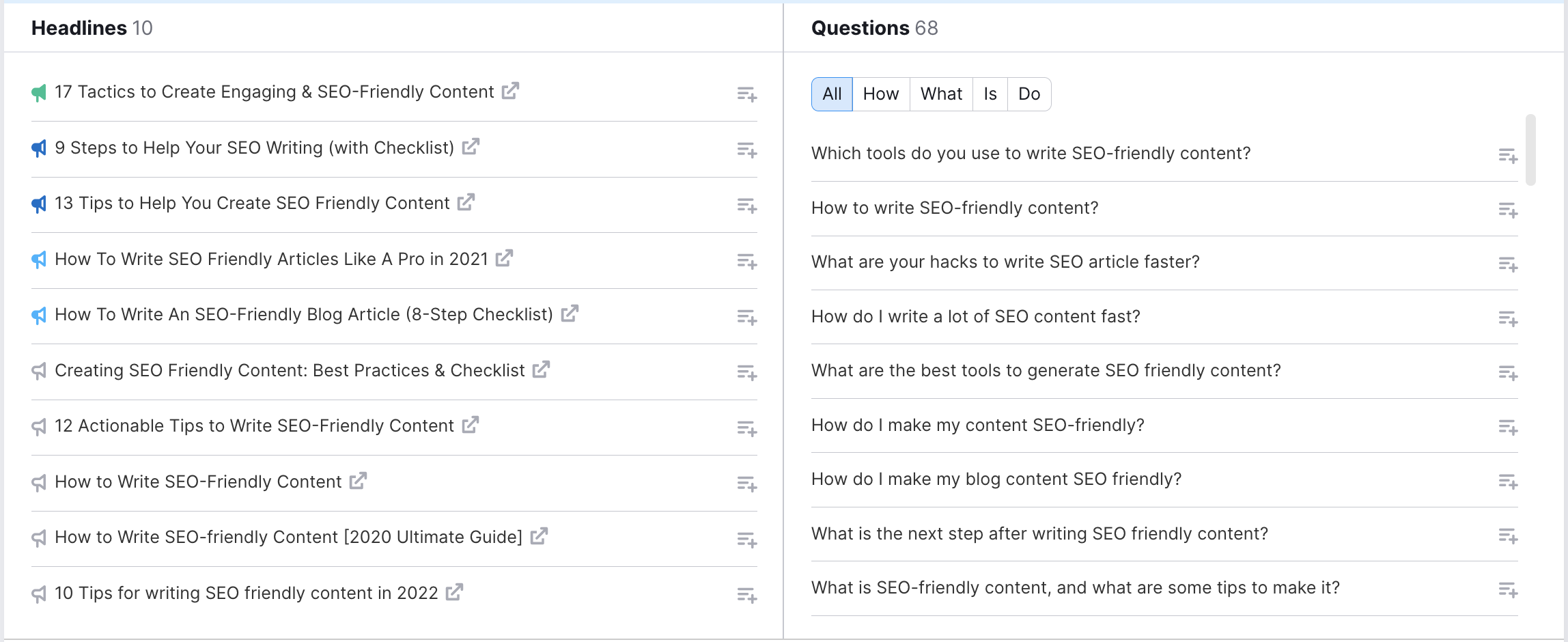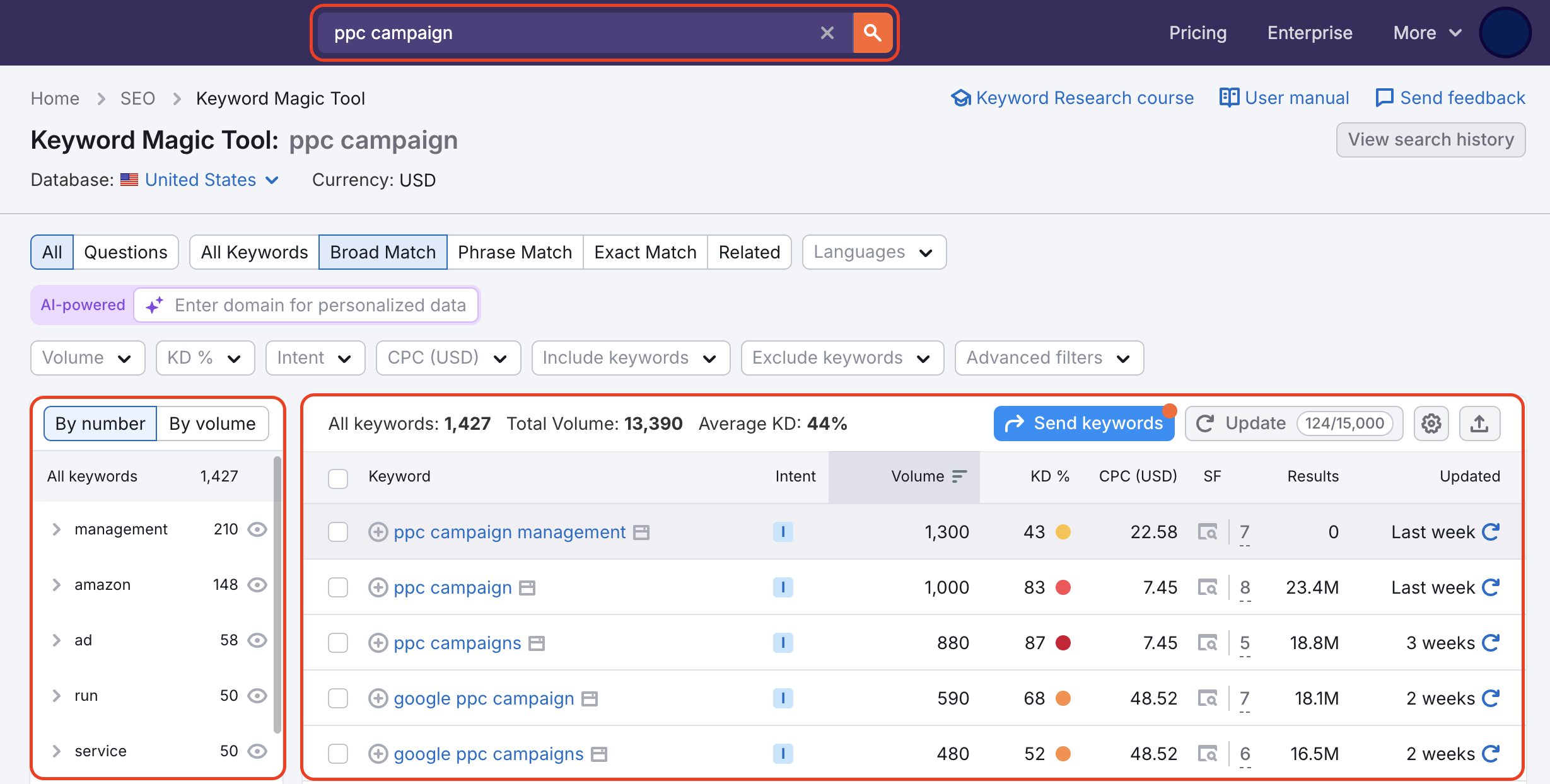Writing effective content is one of the most obvious building blocks to SEO. But like most things, quality comes from a process. Lucky for you, here's an easy four-step process that you can learn today using Semrush's content tools!
This workflow will show you how to conduct research, outline your article, write your content, and review your content to perform for SEO.
Please note: The Content ideas tools included in the SEO Toolkit subscription—SEO Writing Assistant, Topic Research, and SEO Content Template—are fully available only with the Guru and Business tiers.
1. Gather research in Topic Research and the Keyword Magic Tool
An idea is just a new combination of two or more existing elements, so if you want new ideas, you can start by researching what’s already out there.
Topic Research will show all of the existing headlines and questions people ask Google related to your topic of interest so you can get a feel for what’s already out there and find new ideas. Just enter a word or phrase in the search bar and Semrush will generate your topic cards.
You can sort and filter through these cards to find questions, trending topics, topics from on a specific competitor’s website, and more.

If you find a topic that you want to write about, don’t just stop there!
Save everything you like to your Favorite Ideas list. Then, you can come back here when you’ll inevitably be looking for more fresh content ideas in the future.
What the Keyword Magic Tool can do is go more granular with keyword research. This tool will gather all possibilities of related searches and phrases after you enter your seed query into the field. After you enter a target word or phrase, this tool will return a massive list of related keywords, grouped into sub-lists so you can explore all of the entities related to your subject.

A big part of SEO-friendly content is about having effective page titles and headers within the page match up with the keywords you are targeting. So look through the Keyword Magic Tool report and see if you can identify a few keywords that you could use to build an outline for a blog post or web page.
2. Analyze keywords by Keyword Difficulty
Keyword Difficulty is Semrush’s proprietary metric that evaluates how much competition currently exists for a target keyword, allowing you to pick out the low-competition keywords to base your page around.
It can be found as a column in any keyword report on Semrush (it will be labeled KD%), and there is an option to check Keyword Difficulty for keywords in bulk in Keyword Overview Tool.

Select one main target keyword and up to 3-5 related keywords/topics to use in your outline. These additional keywords can be used as subsections and H2s in the body of the text, or simply just an additional point to include in your page if it makes sense to talk about it.
Research points to Google preferring content that covers a wider spread of questions surrounding an entity, or target topic. If you can provide information or answers to questions about a topic from more than one angle, it will increase the value of your content.
3. Generate an SEO Content Template and outline your content
The SEO Content Template, even though it doesn’t have “magic” in its name, is another magical tool on Semrush. All you have to do with this tool is enter the keywords you want to target and Semrush will return a thorough template for your content that includes recommendations on:
- Target word count/article length
- Semantically related words (more words to consider for your outline/writing)
- Target readability score
- Target domains to build backlinks from
- Page title
- Meta description
- Use of target keywords in H1s and text
Once you have these recommendations, combine these suggestions with your research from Topic Research and Keyword Magic Tool to finalize your outline, estimate the text length and start writing!
4. Grade yourself as you write with the SEO Writing Assistant
As you write your SEO-optimized content, you can check how well your article satisfies our recommendations with the SEO Writing Assistant plugin for Google Docs and WordPress.
This plugin can be added to your web browser and what it basically does is integrate the SEO Content Template you generated with a live Google Document or WordPress draft so you can grade your content as it is written.
The Writing Assistant provides a deeper analysis of your content’s tone of voice so you can hone your voice to as serious or casual as you want. Then, it rates your accuracy to the template (and how much you’ve optimized your writing) on a 10-point scale.

This way, you can wait until you have the content as perfect as you can make it before publishing it on the web.
Hopefully you will find this workflow useful to your process! Here are some other tools you may want to check out while you’re optimizing a site:
For more tips, visit our blog and read Tips for Creating SEO-Optimized Content.